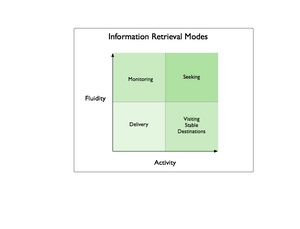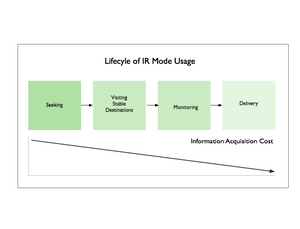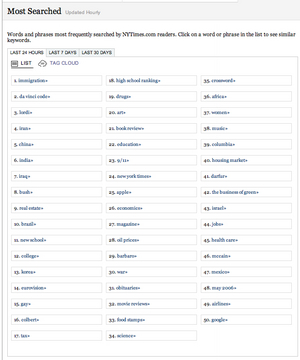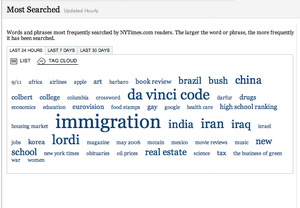Goal Based Information Retrieval Experiences
Though it’s common practice, thinking of information retrieval exclusively as ‘search’ is an arbitrarily narrow way of framing an area of capability with strong impact on overall perceptions of user experience quality and effectiveness. In the long term, it limits opportunities to offer customers more effective solutions to broader and more fully understood needs that involve information retrieval, but are motivated by other goals. This narrow view is especially limiting for the user experience architect, as it implies an immediate focus on the search aspects of information environments.
A better way of framing information retrieval is in terms of opportunities to meet genuine user goals and objectives by supporting more varied modes of activity. Users often have broad goals in mind while they pursue information retrieval activities; buying a car, making a good investment decision, or learning how to manage their health care plans. And yet the information architecture of many environments still overemphasizes searching as a way of accomplishing goals.
Addressing broader goals with an effective information retrieval experience will likely mean supporting modes of interaction beyond just searching. But providing these additional modes and user experience capabilities can open new opportunities for services, features, revenue, improving relationships, etc.
Even in situations where a wide range of users need to select very specific materials from a large archive or pool of content (the traditional library model), a search-centric information retrieval model that offers no/few other capabilities is reductive and overly simplistic.
Instead of immediately focusing on the scope or functionality of a search experience and system installation, look for the patterns in user goals and needs that imply common modes of interaction with information, and use them as a basis for defining capabilities the environment must offer.
Here’s a list of common types of user goals that involve information retrieval – think of them as root goals that take on different specialized forms in differing environments:
- reviewing summaries of items
- examining details
- comparing multiples
- understanding contexts and situations
- learning about people in the environment
- perceiving trends
- predicting implications
- monitoring status or activity
- identifying by criteria
- establishing similarity
- obtaining information for reuse
None of these explicitly includes the activity of searching, though many do imply some level of finding.
For a recent project, we defined four information retrieval or interaction modes that would meet the goals of our expected users:
- seeking information
- visiting stable destinations
- monitoring notifications
- receiving delivered assets
These modes range from more active seeking, to less active receiving delivery, and persistent settings (stable destinations) to fluid settings – monitoring or seeking. Together, they define possible kinds of information retrieval experiences and capabilities that will meet the varying needs and goals of users when properly combined.
Information Retrieval Modes
Seeking
The seeking mode focuses on traditional searching, but includes other activities such as narrowing sets using cumulative parameters, finding with/in faceted systems, and . A classic example of seeking mode is a user who poses an ad-hoc query via a search interface, and sorts through the list of search results returned in response. This list may incorporate many different kinds of items from many different sources, a combination that no other user ever encounters again.
From an information architecture perspective, the key characteristic of seeking mode is that, users bring the situations and contexts (like search results) they encounter into existence by seeking them out. When seeking, users encounter fluid destinations within the larger information environment based on what they are looking for, and how they are looking for it.
Another characteristic of the seeking mode is that users will not know in advance what they will encounter, even though they may have a very good idea of what they need to meet their goal. When seeking, users might be presented with a mixed set of conceptually related items of many different types, from unknown sources, with diverse contents / structure / composition.
Of course, users may not know what they need, or how to ask for it, as Donna Maurer’s 4 Modes of Seeking Information and How to Design for Them points out, but this was a less important factor in the way we framed seeking within our environment than whether users would know what to expect as a result of their seeking activities, and whether they could retrace their path to a particular step of their journey.
Visiting Stable Destinations
When visiting stable destinations, users encounter stable places within the information environment that exist regardless of the user’s activities. Where seeking invokes temporary contexts do not persist, a stable destination is persistent. Persistence could be conceptual only, reflected in navigation elements, or made part of the user experience via any number of mechanisms. All destinations have a focus of some kind, such as a topic, or product, or event, and may be defined by the intersection of several focuses, such as products or documents created by one person that are related to a topic or event.
Destinations could take the form of many kinds of pages – including the A-Z indexes Donna mentions – but could also consist of predetermined combinations of conditions and context that users can revisit without choosing them again. In an environment of known contents, destinations offer users a set of things they understand in advance and expect (after adequate opportunities for learning). Destinations will likely change based on business rules and user context, as well as changes in the items available within the environment.
A good example of a stable destination is the Arts page of the New York Time online; the articles and the art they concern change constantly, yet users know what to expect when they visit. The page is a visible part of the environment conceptually (as a category) and in terms of navigation, and is easily accessible directly from outside the environment.
Monitoring
The monitoring mode is a more fluid and less active information retrieval mode wherein the environment sends users notifications of events, activity, status, or changes taking place within it’s boundaries. The key characteristic of monitoring is that users can accomplish goals without entering the environment, or with only limited entry that takes them to a known setting.
Monitoring effectively extends the user experience and information retrieval capabilities beyond the boundaries of the originating environment, and allows users to know in advance what they will find or encounter when they enter the environment.
Monitoring naturally requires messages or communication tokens, commonly email, RSS, or SMS, but could take many other forms as well. A good example of monitoring is the configurable alerts that many travel services provide to indicate when prices for airline tickets to specific cities change, or match a price point.
Receiving Items via Delivery
Receiving delivered items is the least active mode we defined for users, allowing them to retrieve information without actively seeking, visiting a destination, or monitoring the environment. In this mode, users do not have to enter the environment at all to retrieve information, enabling them to further goals without increasing acquisition costs or effort.
Delivery implies mechanisms to manage the nature, rate, and format of the information to deliver, as well as the channel: email, attachments, RSS, podcasts, vlogs, etc.
Good examples of delivered information are the iconic stock ticker, RSS feeds for blog postings, and email publications.
Combining Modes: User Goals and Customer Lifecycles
It’s natural that user goals will span modes, and that the preferred mode for accomplishing a goal may change over time to reflect shifting usage patterns and needs.
As an example, a single user might shift among different modes that reflect learning more about the structure and content of the environment. From initial seeking activity focused on searching for information related to a topic, a user may switch to visiting a known stable destination that addresses that topic, entering the environment from the outside without initial seeking.
This destination may include tools to establish monitoring for a specific type of item, which a user who understands the domain will appreciate and take advantage of as a way to reduce the number of required visits while remaining aware of activity or status. Eventually, this user might shift from monitoring to direct delivery of a few specific and very valuable information assets, through a channel and in a format of their choosing.
IR Mode Lifecycle
In the same way that patterns in goals allow experience architects to identify common modes of information retrieval, patterns of cross-mode usage will emerge in populations of users or customers. Once understood, these kinds of flows present opportunities on many levels; user experience, business model or process, and technical architecture.
Related posts:













